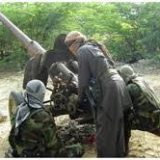Al-Shabaab is failing in Somalia, but Kenya’s chaotic response could keep it alive
On December 2, 2014, gunmen from the militant Islamist group al-Shabaab crept into a labourers’ camp in Mandera in Kenya and killed 36 people. In the same all-too-familiar modus operandi seen in the same area in the November bus attack, in Mpketoni in June and at the Westgate mall in Nairobi in September 2013, Christians were singled out for execution.
This time, the attackers demanded that the victims recite Quran verses; if they failed, they were executed.
These massacres appear to indicate a increase in the severity of attacks near Kenya’s border with Somalia. Violence is not new there; there have been frequent outbreaks of violence in the northern part of the border region for some years, often featuring Somali guerillas and clan fighters. This was the area of the so-called Shifta Wars between Kenyan- and Somali-supported insurgents before the collapse of the Somalian state.
But during the past year, the attacks have grown in scale. The mass killings of the last few months are not a part of the usual modus operandi of the border clashes, which often resemble raids rather than executions. And sure enough, as with the Westgate attack and the Mpketoni attack, al-Shabaab took responsibility quite quickly for these recent incidents.
Kenya’s president, Uhuru Kenyatta, tried to claim that the latter attack was not the work of al-Shabaab, but it was far from a normal tribal attack in the area. Tribal groups have never before in the history of Kenya systematically separated Muslims and non-Muslims for the purposes of mass execution.
That said, al-Shabaab could have some form of local backing; indeed, problems between police and Islamists has been relatively intense in Mombasa, Kenya’s largest port city. But it should not be missed that, despite the latest attacks, these are tough times for the Horn of Africa’s feared Islamists.
Onward and upward
The group is rapidly losing ground inside Somalia, which is well embarked on an admittedly rocky road towards decentralisation and federalism. A general peace has been struck between the various clan-based factions that had been tearing the country apart for decades – and this is slowly and steadily leading Somalia towards a functional political system grounded in local government. Given where the country has been, the results are remarkable.
In the capital, Mogadishu, the United Nations security services have downgraded some areas to the classification of “moderate danger” for the first time since the war started. I myself have spent many a nice afternoon shopping alone in parts of the city that were once lethal no-go areas. There are still attacks inside the capital, but they are markedly less frequent than even one year ago – and they’re shorter too, normally lasting only about 15 minutes.
In this strange atmosphere of incremental improvement, al-Shabaab is using grandstanding terrorism to divert attention from its heavy political and military losses.
Terror attacks make up an ever-growing share of al-Shabaab’s activities. Outside Mogadishu, the group cannot hope to face the power of the African Union in open combat, since the AMISOM forces are vastly superior in numbers, training and equipment.
However, al-Shabaab still has some cards up its sleeve; AMISOM does not control the countryside, and the group still holds some strategic villages controlling major roads, enabling them to tax Somali traffic. AMISOM and its Somali allies are still too small and, in the case of the latter, too clan-based and poorly trained and paid to secure the central Somalian countryside.
Al-Shabaab has also survived similar pressure before, when Ethiopia controlled southern Somalia in 2007 to 2009 – but has prevailed. The group has once again, under heavy pressure, maintained relative unity, and defections apparently remain negligible.
Al-Shabaab is changing. In an era where many radical Sunni Islamist organisations are expanding their territorial controls as never before – see Boko Haram and Islamic State – al-Shabaab, which in many ways started the trend, is in retreat.
That obviously poses major challenges to the group’s survival. Lost tax income from recaptured areas will be sorely missed; Al-Shabaab’s governance is increasingly challenged locally in the few areas they control, making it hard for it to claim coherence or credibility even in a state as chaotic as Somalia.
But at the same time, al-Shabaab has several advantages. Although the large attacks in Kenya have clearly been staged from Somalia, Kenya now has its own Islamist problem and, thanks in part to al-Shabaab’s actions, the counter-strategies of the Kenyan leaders (such as mass arrests) have simply proved ineffective.
Falling behind
Most of all, the attacks have also shown that Kenya’s original mission in Somalia, which aimed to protect the country from terrorists acting across the border, has utterly failed.
That does not mean Kenya pulling out of Somalia would keep Kenyans safe. Al-Shabaab increasingly premises its attacks on Kenyan domestic events – the bus attack, for example, was said to be in revenge for police raids on mosques in Mombasa. Meanwhile, the group’s interest in Kenya has also galvanised the country’s homegrown violent Islamists, who have staged domestic attacks of their own – though so far relatively unprofessionally.
As long as al-Shabaab is on the decline inside Somalia, there is at least a ray of hope. But Kenya has its work cut out. It needs to make sure internal tension does not divide the political elite to the point of impotence. It also has to find a way to end the crippling corruption of the security services, which are accused of systematically assassinating domestic Islamists.
While Somalia pushes ahead with its precious and fragile gains, Kenya is falling behind on both fronts – and that could yet be al-Shabaab’s salvation.




















